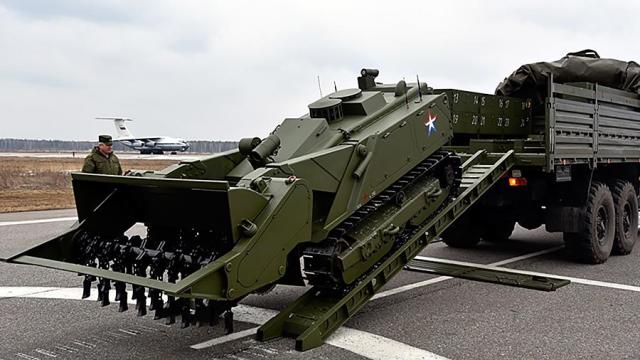Russian navy sailors received "coastal minesweepers". A fundamental decision was made to equip the engineering regiments of the Navy with combat robots-sappers "Uran-6". They can be used with maximum safety for the personnel to clear explosive hazards from the coast and the hinterland. Now the ground forces already have several dozen of these remote-controlled vehicles. They were successfully used for mine clearance in Syria, Nagorno-Karabakh and Chechnya. Thanks to the "Urans", Russian sappers destroyed thousands of explosive devices, experts said.
Russian navy sailors received "coastal minesweepers". A fundamental decision was made to equip the engineering regiments of the Navy with combat robots-sappers "Uran-6". They can be used with maximum safety for the personnel to clear explosive hazards from the coast and the hinterland. Now the ground forces already have several dozen of these remote-controlled vehicles. They were successfully used for mine clearance in Syria, Nagorno-Karabakh and Chechnya. Thanks to the "Urans", Russian sappers destroyed thousands of explosive devices, experts said.
Robots for the Navy
It was decided to equip all marine engineering regiments with mobile robotic mine-clearing systems MRTK-R "Uran-6", sources in the Ministry of Defense told Izvestia. With the help of tracked remote-controlled vehicles, they will clean up the coast and land from mines. If necessary, they can also be attached to Marine Corps units. The capabilities of the equipment allow us to use it for the elimination of the consequences of man-made accidents. The first complexes have already entered service with the Black Sea Fleet.
Serial delivery of "Uran-6" to the ground engineering and sapper units began two years ago. More than 20 cars have already been received. In August 2020, the Ministry of Defense announced the largest-ever exercises of the engineering troops with the use of robotic systems. At the test site in the Astrakhan region, 10 remote-controlled Urans simultaneously created a passage in a simulated minefield. Together with them, the fire-fighting robots and engineering vehicles of the barrier worked.
The curb weight of "Uran-6" reaches 7 tons. On a tracked light armored vehicle, you can hang three replaceable trawls designed to work on different types of soil, as well as a bulldozer blade and a manipulator. Such equipment allows the complex to deal not only with mine clearance, but also with clearing obstacles. Nevertheless, the main purpose remains the destruction of explosive devices, primarily anti-personnel mines. It is stated that on flat terrain, one unit of equipment replaces 20 sappers.
"Uran-6" is not able to act independently. It is controlled remotely by radio communication. In this case, the operator can be at a distance of up to 800 m from the robot. This completely protects it from the dangers associated with mine clearance.
"The Marine Engineering Service combines both combat and civilian components — "Admiral Valentin Selivanov, the former Chief of the Navy's General Staff, told Izvestia. — On the one hand, it provides the garrisons. It is responsible for the municipal services. On the other hand, it includes combat units, in particular sappers.
Previously, during amphibious operations, assault charges of mine-clearing installations were used to ensure the landing of combat vehicles and marines, the admiral explained.
- The robot will most likely be able to operate at shallow depths off the coast-to detect mines, install buoys marking them and destroy explosive objects, - said the expert. — This is a good decision in the current conditions. Our fleet operates in the area of Syria, and may work in other regions as well. And the Russian coast must be protected. Of course, minesweepers or aircraft will not be able to place mines on it unnoticed, but small-sized ammunition can be placed by underwater saboteurs. In this case, the robot will also be useful. I assume that the naval version of the complex will be further improved taking into account the marine specifics.
Foreign roots
Work on the new robotic complex started in the early 2010s. And in the summer of 2014, the test "Uran-6" was sent for military tests in Chechnya and Ingushetia. The technicians were tasked with clearing farmland from old minefields. On 60 hectares, the complex destroyed explosive devices with a total weight of 40 kg.
In 2015, "Uran-6" was officially accepted for supply. The first samples were sent to the International Mine Action Center of the Russian Armed Forces, intended for humanitarian operations abroad.
Since the spring of 2016, the specialists of the mine action center have been working in Syria. An engineering robot participated in the clearing of explosive objects in Palmyra and Aleppo after their liberation from terrorists. It was there that it was tested together with the EO-1 passive exoskeletons, which protected the operators. So it was easier for the sappers to work with the machine for hours in a hot climate, having communication and control equipment with a total weight of 20 kg.
Recently, such a machine was used in Nagorno-Karabakh. "Uran-6" cleared cities and towns of unexploded ordnance and mines, as well as roads between checkpoints of Russian peacekeepers.
In 2018, the Ministry of Defense announced the modernization of the complex with a new mobile platform with a hydrolift based on a four-axle truck "KamAZ". It allows you to unload and load heavy robots without assistance. This is important for autonomy when operating abroad, in war zones and man-made disasters. The compact size of the complex and the robot make it easy to transfer it by military transport aircraft to the right place.
In addition to the sapper robot, the Uran family also includes an even heavier Uran-14, designed to extinguish fires in artillery depots. It was developed by the Croatian company DOK-ING. It also has a domestic filling-a reconnaissance and assault "Uran-9", armed with anti-tank missiles and a 30-millimeter automatic gun.

